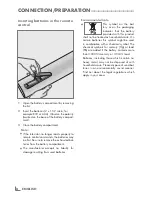
ENGLISH
6
GENERALINFORMATION
-------------------------------------------------------------------
Importantnotesonenvironmen-
talprotection
Those items mentioned below will help you re-
duce the consumption of natural resources as
well as save your money by reducing electricity
bills.
7
If you will not be using the TV set for several
days, it should be disconnected from the mains
for environmental and safety reasons. TV will
not consume energy in this condition.
7
If the TV set has main switch, it will be enough
to turn the TV off via main switch. TV will re-
duce energy consumption almost to Zero
Watt.
7
TV consumes less energy on stand by mode.
However, some TV sets may have features
such as on timer, that require the TV set to be
left in standby to work correctly.
7
TV consumes less energy when brightness is
reduced.
Notesonstillimages
Watching the same image for a long time on the
screen may cause a still image remain feebly on
the background. Feeble image(s) on the back-
ground is originated from LCD/LED technology
and does not require any action under guaran-
tee. To avoid such cases and/or minimize the
impact, you may observe the tips below.
7
Do not allow the same TV channel to stay on
the screen for a very long time. Channel logos
may cause this situation.
7
Do not allow the images, which are not full
screen, to constantly stay on the screen; if not
streamed in full screen format by the broad-
caster, you can convert the images to full
screen by changing picture formats.
7
Higher brightness and/or contrast values will
lead this impact to appear faster; therefore,
you are recommended to watch your TV in the
lowest brightness and contrast levels.
7
Devices that contain and serve video, music
or image files are called Server. This tele-
vision receives video, music and image
files from the server through home net-
work, allowing you to access and play
such media even when your television is
located in a different room then the server.
A DLNA compatible device such as a PC,
mobile phone, NAS or a NAS-like (Network
attached storage) device which operates as
a DMS (Digital Media Server) is required in
order to use home network.
Receivingdigitalstations
7
To receive digital satellite stations (DVB-S) you
need a satellite antenna.
7
To receive digital stations (DVB-T) you need a
digital rooftop or indoor antenna (passive or
active indoor antenna with its own power sup-
ply).
7
The antenna cable of the cable TV network
that broadcast in DVB-C must be plugged into
TV in order to receive the DVB-C broadcasts.
7
Unlike analogue broadcasting, not every sta-
tion has its own transmission frequency. In-
stead, several stations are grouped into what
are known as bouquets on a regional or na-
tional level.
7
You can find the current transmission informa-
tion on teletext from various broadcasters, or
look in a TV guide or on the Internet.
7
Various digital television stations from private
broadcasters are encrypted (DVB-S, DVB-T
and DVB-C). Watching these stations and the
recording and playback functions are only
possible with the appropriate CI module and
a SmartCard. Ask your specialist dealer.
GRUNDIGSCRSystem
7
Your TV supports SCR system (Single Chan-
nel Router). With SCR satellite system, several
users can individually receive all signals from
the satellite simultaneously.
Содержание Toronto 55 CLE 6545 AL
Страница 1: ...EN Toronto 55 CLE 6545 AL ...








































